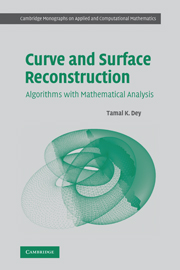5 - Undersampling
Published online by Cambridge University Press: 20 August 2009
Summary
The surface reconstruction algorithm in the previous chapter assumes that the sample is sufficiently dense, that is, ε is sufficiently small. However, the cases of undersampling where this density condition is not met are prevalent in practice. The input data may be dense only in parts of the sampled surface. Regions with small features such as high curvatures are often not well sampled. When sampled with scanners, occluded regions are not sampled at all. Nonsmooth surfaces such as the ones considered in CAD are bound to have undersampling since no finite point set can sample nonsmooth regions to satisfy the ε-sampling condition for a strictly positive ε. Even some surfaces with boundaries can be viewed as a case of undersampling. If Σ is a surface without boundary and Σ′ ⊂ Σ is a surface with boundary, a sample of Σ′ is also a sample of Σ. This sample may be dense for Σ′ and not for Σ.
In this chapter we describe an algorithm that detects the regions of undersampling. This detection helps in reconstructing surfaces with boundaries. Later, we will see that this detection also helps in repairing the unwanted holes created in the reconstructed surface due to undersampling.
Samples and Boundaries
Let P be an input point set that samples a surface Σ where Σ does not have any boundary.
- Type
- Chapter
- Information
- Curve and Surface ReconstructionAlgorithms with Mathematical Analysis, pp. 80 - 92Publisher: Cambridge University PressPrint publication year: 2006



